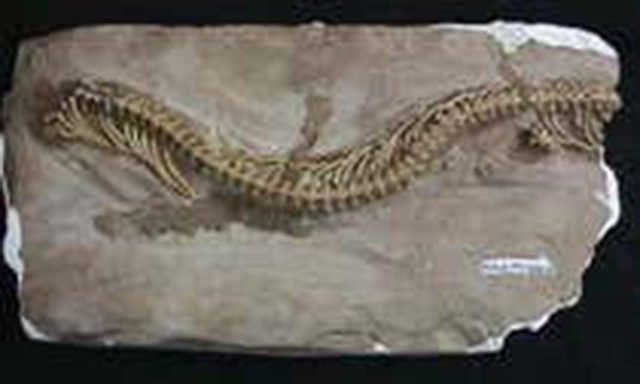
An articulated portion of the Najash fossil. (Image: H Zaher)
Paleontologists in Argentina reached for their Bibles after finding fossils of snakes with hind legs.
The report published Thursday in the journal, Science Advances, estimates the fossils found in the Rio Negro Province, Patagonia in 2013. The fossil is believed to be 95 million years old. The new discovery was appropriately named najash rionegrina. The term najash is based on the Hebrew word נחש (nachash, snake).
The scientists based their theory on fragments of a nearly complete skull which indicated they were very similar to lizards. Their shared anatomy led scientists to conclude that snakes evolved from lizards. Previous theories held that snakes evolved from small worm-like burrowing lizards with four legs. No fossils were ever found to corroborate this theory.
One theory suggested that the two-legged fossils represented a temporary stage in which the snakes transitioned from four legs to none but the researchers concluded that the two-legged stage lasted tens of millions of years.
Though some lizards are legless, the new discovery is of a skull with a large mouth and sharp teeth which is entirely different than that of lizards. The skull also had mobile joints for the jaw, much like modern snakes. The najash probably fed on large prey and were similar in size to the modern-day big-headed, big-bodied lizards like the Komodo dragon.
“Snakes are famously legless, but then so are many lizards. What truly sets snakes apart is their highly mobile skull, which allows them to swallow large prey items”, said Dr. Alessandro Palci, from Flinders University in Australia told The Daily Mail. “For a long time, we have been lacking detailed information about the transition from the relatively rigid skull of a lizard to the super flexible skull of snakes.”
Researchers say that Najash has the most complete, three-dimensionally preserved skull of any ancient snake ever found.
“It has some, but not all of the flexible joints found in the skull of modern snakes. Its middle ear is intermediate between that of lizards and living snakes, and unlike all living snakes it retains a well-developed cheekbone, which again is reminiscent of that of lizards”, said Dr. Palci.
The new discovery is consistent with the story in Genesis which states that the snake was punished for tempting Eve.
The LORD God said to the serpent, “Because you have done this, cursed are you above all livestock and above all beasts of the field; on your belly you shall go, and dust you shall eat all the days of your life . Genesis 3:14
Since the punishment was to crawl on its belly, it is surmised that prior to the punishment, the snake did not crawl and may have had legs.
In gematria (Hebrew numerology) nachash (snake) נחש equals 358, the same as Moshiach (Messiah) משיח. The Zohar (the basis of Jewish mysticism) explained that the evil inclination, personified by the snake in Eden, will make a resurgence in the days before Messiah, tempted to come and drink sustenance from the enormous levels of holiness that will appear in the world in the end-of-days.
Another connection between the lowly snake and holiness is implicit in the Hebrew words. The letters of the word נחש (nachash; snake) can be rearranged to spell חושן (choshen; breastplate), worn by the high priest in the Temple. The Zohar states that the tikkun (fixing) of the snake’s sin in the Garden of Eden would be accomplished in the Third Temple by way of the breastplate. Perhaps, after the Third Temple is built, snakes will once again walk on their legs.
But the most remarkable non-snake-like aspect of the new find was a well-defined sacrum supporting a pelvis and functional hind legs outside of its ribcage. Another theory held that snakes developed as marine reptiles, losing their legs in the oceans, evolving from now-extinct marine lizards called mosasaurs. Though some species of sea snakes still have vestigial legs, the najash was decidedly a desert dweller.
“This snake is an important addition because it is the first snake with a sacrum. This represents an intermediate morphology that has never before been seen,” says Hussam Zaher, curator of herpetology at the University of São Paulo in Brazil, and part of the research team told New Scientist.
“‘Snakeness’ is really old, and that’s probably why we don’t have any living representatives of four-legged snakes like we do all of the other lizards,” Michael Caldwell, a vertebrate paleontologist at the University of Alberta and a co-author of the study, explained to the New York Times.
“Snakes probably were one of the first lizard groups to start experimenting with limblessness, but what’s really intriguing is that they were also very clearly showing the characteristics of their skulls, which are their specialization,” he added.

